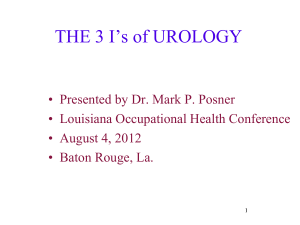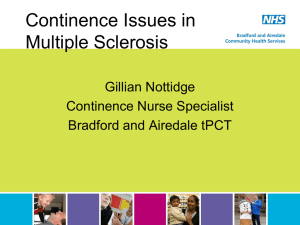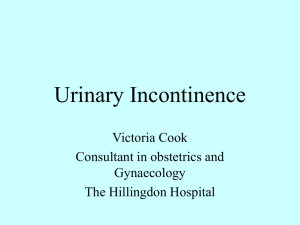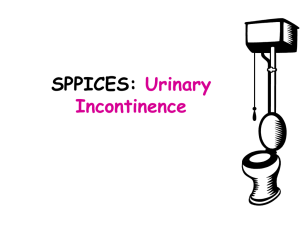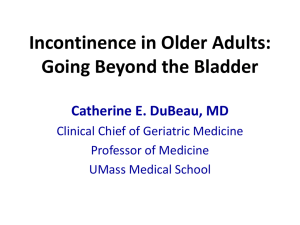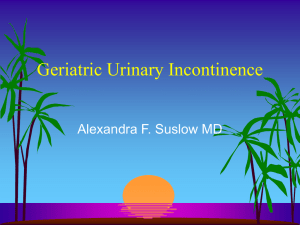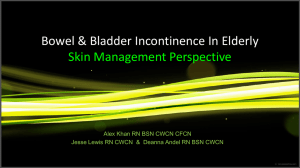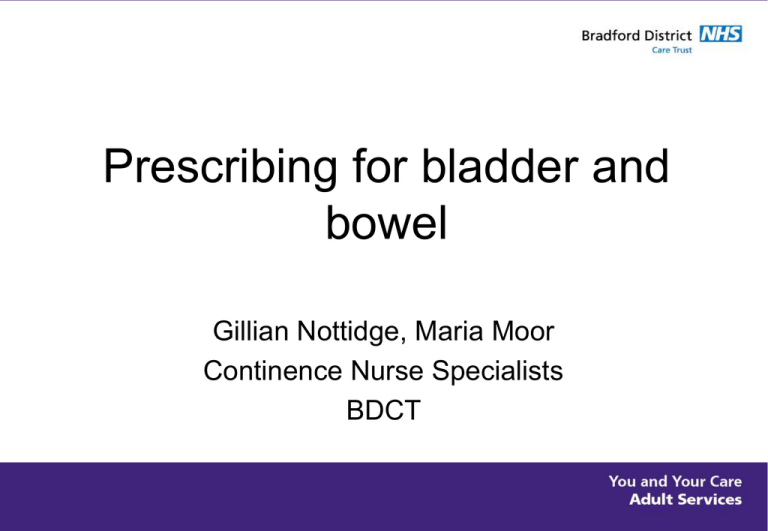
Prescribing for bladder and
bowel
Gillian Nottidge, Maria Moor
Continence Nurse Specialists
BDCT
Aims of this session
• Overview of incontinence
• Medical management
Cute
Not so cute
Facts and statistics
• WHO report that bladder control problems affect more than 200m people
worldwide and that it is “a largely preventable and treatable condition”
• The NHS estimates that between 3 and 6 million people in the UK have some
degree of urinary incontinence.
• In the UK, 24% of older people are affected by urinary incontinence.
• In institutional care, 30-60% are affected by urinary incontinence
• A study in 2002 found that 32% of women in the UK, 34% in Germany, 32% in
France and 15% in Spain had symptoms of urinary incontinence in the previous
30 days.
Definition of Urinary
Incontinence
The complaint of any
involuntary leakage of urine
Abrams 2002
The psycho – social impact of
incontinence
• Work
• Exercise
• Travelling
• Socialising / relationships
• Anxiety
• Depression
The physical impact of incontinence
•
•
•
•
•
Increased risk of falls
Skin problems
Pressure ulcers
Urinary tract infections
Delayed discharge
Environmental cost
Types of Incontinence
•
•
•
•
•
Urge incontinence (Overactive bladder)
Stress incontinence
Overflow incontinence
Constipation
Faecal incontinence
What is bladder overactivity?
• It is the strong and
sudden need to pass
urine due to bladder
spasms which may
result in incontinence
Why Does it Happen?
• The bladder is a muscle that can hold around 500mls of urine.
Around 200-300mls may get a sensation to urinate
• Normal bladder: passing urine is under voluntary control
• Overactive bladder: becomes increasingly involuntary
– The bladder starts to contract driving a sudden and strong
urge to pass urine, often with little warning
Symptoms
•
•
•
•
An urgent need to urinate
The need to urinate often, 8 or more times a day
Waking up to urinate 2 or more times a night
The need to urinate even if you have just gone to the
toilet
• Taking many trips to the toilet only to urinate just a little
bit each time
• Leaking urine when you have the urge to urinate
Risk factors for overactive bladder
• Nervous system conditions can increase susceptibility
– Diabetic Neuropathy
– Multiple sclerosis
– Stroke
– Spinal cord Injury
– Dementia
– Parkinsons
• Idiopathic Overactive bladder
– No cause can be found
• Obesity
Management of OAB
• Reduce caffeine intake
• Minimise alcohol intake
• Drink adequate
amounts of healthy
fluids
•
•
•
•
Pelvic floor exercises
Bladder retraining
Avoid constipation
Anticholinergic
medication
Non-medical prescribing
• Examine the holistic needs of the patient. Is a
prescription really necessary?
• Consider the appropriate strategy
• Consider the choice of product
• Negotiate a contract and achieve concordance with
the patient
• Review the patient on a regular basis
• Ensure record keeping is both accurate and up-todate
• Reflect on your prescribing
Physical and Psychological effects
•
•
•
•
•
Increased risk of falls
Depression and anxiety
Social isolation
interpersonal relationships
Decrease in sexual function
Diagnosing Overactive Bladder
• Thorough assessment to include:– Past medical history
– Bladder diary for 3 days
– Urine test
– Post void residual ultrasound scan
– Pelvic examination
Behavioural Therapy
• Supervised pelvic floor muscle training
• Bladder training for 6 weeks (Nice 2006)
• In combination with fluid and lifestyle advise
• Understanding the causes and risk factors
Anticholinergic Medication
•
•
•
•
•
•
•
Oxybutynin
Tolterodine
Fesoterodine
Solifenacin
Trospium
Trospium XL
Darifenacin
How do they work?
• block the neurotransmitter, acetylcholine in the
central and the peripheral nervous system.
• operate on the muscarinic acetylcholine receptors.
• Muscarinic receptors in smooth muscle, especially
gastro-intestinal system, eyes, brain
• M3 receptors more specifically in bladder
Therapeutic effects
•
•
•
•
Reduces frequency
Reduces urgency
Reduces nocturia
.
Reduces urge incontinence
Side effects
•
•
•
•
•
•
Dry mouth
Dry eyes/altered eye accommodation
GI disturbances/increased gastric secretions
Constipation
Cognitive impairment
Increased residual/urinary retention
Contra-indications
•
•
•
•
•
•
Pregnancy and lactation (no available data)
Narrow-angle glaucoma
Allergy
Severe renal/hepatic impairment
Urinary retention/high residuals
Myasthenia gravis
Interactions
• Ketoconozole increases action of
anticholinergic
• Anticholinergics can reduce absorption of
Levadopa
Pros and cons of each drug
• Oxybutynin
• Oxybutynin patches
Advantages
Effective, cheap
Licensed in <18s
Better tolerated
than oral Oxybutynin
• Tolterodine
Effective
• Fesoterodine
More effective
Both doses same price
Disadvantages
Side effects
Skin irritation
cardiac side effects
New drug so no
long term data
Pros and cons of each drug
•
•
Trospium
Trospium XL
•
Darifenacin
•
Solifenacin
• Advantages
Does not cross
Blood/brain barrier
Disadvantages
bd dose
1 hour before food
Does not cross
Blood/brain barrier (label23)
Tolerated in elderly
Recommended in obesity
1 hour before food
Does not cross
blood/brain barrier
Tolerated in elderly
Selects M3 receptors
availability
Effective
Minimal CNS s/e
GI disturbances
10mg dose expensive
So which drug?
• NICE recommend Oxybutynin IR first line
– Remember it is just a guideline
• NHS spend is £80 million annually on 2nd line
drugs for OAB
– NICE make no recommendation re 2nd choice
– Counsel re risks and benefits of each drug
Price per 28 days
•
•
•
•
•
•
•
•
•
Oxybutynin IR
Oxybutynin MR
Oxybutynin patches
Trospium bd
Trospium XL
Solifenacin
Tolterodine
Darifenacin
Fesoterodine
•
•
•
•
•
•
•
•
•
£5.89-31.78
£10.29-£14.16
£27.20
£24.27
£23.05
£25.78-£33.52
£25.78-£30.56
£26.13
£25.78
Botox
• Reduces symptoms
• Minimal hospitalisation
• Effective in neurogenic
conditions
• Not a single treatment
• May need to selfcatheterise
• Used off license
STRESS INCONTINENCE
“the complaint of involuntary leakage on effort
or exertion, or on sneezing or coughing”
(Abrams 2002)
Symptoms of Stress Incontinence
Small leak of urine on:
• Coughing
• Sneezing
• Exercise
• Getting up out of chair
• Picking baby up
Causes of Stress Incontinence
•
•
•
•
•
•
Childbirth
Obesity
Chronic chest problems
Prostatectomy
Chronic constipation
Weakened pelvic floor
Management of Stress Incontinence
•
•
•
•
•
•
•
•
Pelvic floor exercises
Squeeze while you sneeze!
Adequate fluids – avoid caffeine and alcohol
Double voiding
Electrical stimulation
Urodynamics
(Duloxetine)
TVT sling procedure
Duloxetine – the wonder drug?
• is thought to work by increasing the tone of the
urethral sphincter by its action on serotonin
and noradrenaline in the spinal cord.
• prevents re-absorption of serotonin and
noradrenaline
• used to treat moderate to severe stress
incontinence
Side effects
• Dizziness and fatigue
• Postural hypotension or
fainting
• Hypertension
• Hyponatraemia drowsiness, confusion,
muscle twitching or
convulsions.
• Nausea vomiting and
diarrhoea
• Dry mouth
• Headache
• Reduced libido or
anorgasmia
• Sweating
• Tremor
• Blurred vision
• No data for use in
pregnancy/lactation
Atrophic vaginitis
•
•
•
•
•
Reduced oestrogen post menopause
Vaginal dryness – pain on intercourse
Vulval soreness and itching
Increased risk of incontinence
Increased risk of vaginal and urinary tract
infection
Atrophic vaginitis
• Avoid shower gel, soap, talc
• Wash and moisturise the vulva with
Aqueous cream/Diprobase
• Topical oestrogen – pessaries or cream
• Lubricant for intercourse – Sylk
Local oestrogen
• Contraindications
• History or risk of breast
cancer
• Pregnancy or planning
pregnancy
• Current or previous
thrombosis
• Abnormal LFTs
• Sensitivity to product
•
•
•
•
•
Side effects
Vaginal discharge/bleeding
Headache
Genital candiasis
Breast tenderness or
enlargement
• Nausea
Dribbling/Overflow Incontinence
Symptoms
•
•
•
•
•
•
•
Hesitancy
Poor flow
Interrupted flow
Post micturition dribble
Frequency
Urgency
Nocturia
• Urge incontinence
• Urinary tract infections
• Feeling of incomplete
emptying
• Large residual urine
volume
• Passive incontinence
Dribbling/Overflow Incontinence
Symptoms
•
•
•
•
•
•
•
Hesitancy
Poor flow
Interrupted flow
Post micturition dribble
Frequency
Urgency
Nocturia
• Urge incontinence
• Urinary tract infections
• Feeling of incomplete
emptying
• Large residual urine
volume
• Passive incontinence
Obstructive causes of overflow
incontinence
•
•
•
•
•
Outflow Obstruction
Enlarged Prostate
Urethral Stricture
Uterine Prolapse
Constipation
Neurogenic causes of overflow/
dribbling incontinence
• Multiple Sclerosis
• Parkinson's Disease
• Spinal cord injury
• Spina Bifida
• Brain Injuries
• Pelvic Surgery
Management of Overflow
•
•
•
•
•
Double voiding
Treat constipation
Treat enlarged prostate or other obstruction
Intermittent Self-catheterisation
Long-term supra-pubic catheter
Size matters !
BAUS (2004) guidelines
– Size over 30g
– MTOPS study says over 25g
– PSA greater than 1.4 ng/ml in the absence of CaP
Early intervention with 5-ARI
– Can reduce need for surgery by about 50%
– Has been shown to reduce risk of progression to acute
retention by 55%
Medical Management
• Alpha-blocker
Tamsulosin
Doxazosin
Alfuzosin
• 5-alpha-reductase inhibitor
Finasteride
Dutasteride
• Combined therapy (BAUS 2004)
Combidart
Alpha-blockers
•
•
•
•
•
Relax smooth muscle
Relax bladder neck
Improve flow
more complete emptying
Reduction in nocturia = reduction in falls
Alpha-blockers – side effects
• Postural hypotension or
dizziness
• Drowsiness
• Tiredness
• Headache
• Irritability
• Decrease in semen
• Retrograde ejaculation
• Stuffy or runny nose,
nausea,
• Pain in the arms and
legs,
• Weakness
• Tamsulosin most
selective
5-Alpha reductase inhibitors
• Androgen blockade
• Reduces prostate size
• Used in male pattern baldness. (Only in
America!)
Side effects
• erectile dysfunction
• decreased libido
• decreased volume of
ejaculate
• pain in the testicles
• changes in the breasts
eg. increased size,
lumps, pain, or nipple
discharge
•
•
•
•
rash
itching
hives
swelling of the lips and
face
• Tablets should not be
handled by pregnant
women
Intermittent Self-Catheterisation
• Intermittent
catheterisation is far
from being a modern
idea.
• Urology was
probably the very
first medical subspeciality
Intermittent Self-Catheterisation
Containment Products
Other products
The last resort
Bowel problems
• 6.5 million people in the UK with some form of bowel
problem 1:10 (bladder & bowel foundation 2011)
• Slow transit
• Chronic constipation
• Obstructed defaecation
• Faecal incontinence
Evacuatory disorders
and constipation
• Spend on laxatives in the UK is over £50
million per year. (Allen 2007)
• Anal irrigation recommended by NICE (2007)
Bowel management
•
•
•
•
•
•
Diet and fluids
Exercise if possible
Osmotic laxatives
Stimulant laxatives
Suppositories/enemas
Anal irrigation
Macrogols
• contains sodium bicarbonate, sodium chloride and
potassium chloride
• an inert substance that passes through the gut
without being absorbed into the body.
• increases the water content and volume of the stools
in the bowel
• electrolytes included to ensure that it works without
causing the body to gain or lose significant amounts
of sodium, potassium or water.
Stimulant laxatives
•
•
•
•
Bisocodyl, Senna
speed up gut motility
for occasional use only
Griping pain
Types of irrigation
• Gravity feed cone system
• Electrical pump system
• Rectal catheter pump system
Gravity feed cone system
•
•
•
•
Qufora
Patient holds cone
in place
Gravity assists
flow of water
Performed on
toilet
Water and faeces
empty into toilet
Pump Cone system
•
•
•
•
Biotrol pump
Patient holds cone
in place
Pump assists flow
of water
Performed on
toilet
Water and faeces
empty into toilet
Catheter system
•
•
•
•
Peristeen
Rectal catheter held in
place by balloon
Water pumped into
bowel
Performed on the toilet
Water and faeces
empty into toilet when
balloon released
Never teach irrigation to the
following patients:
• Acute inflammatory bowel • Severe cognitive
impairment (unless
disease
tolerated and carer able
• Known obstructing rectal
to supervise/administer)
or colonic mass
• Pregnant or
• Rectal or colonic surgical
breastfeeding
anastamosis within the
last 6months
Proceed with caution
• Spinal cord injury at or above T6 – risk of
autonomic dysreflexia – 1st two
irrigations must be supervised
• Unstable metabolic conditions – renal or
liver disease
• Physical or cognitive disability/mental or
emotional disorder
• Anorectal conditions that cause pain or
bleeding (e.g anal fissure, 3rd degree
haemorrhoids)
Proceed with caution
• Pregnant or planning
pregnancy
• Any bowel or abdominal
surgery within the last 6
months
• Acute diarrhoea
• Anal fissure
• Large haemorrhoids that
bleed easily
• Past pelvic
radiotherapy which has
caused bowel problems
• Severe diverticular
disease
• Rectal medications for
other diseases
• Congestive cardiac
failure
• Anal surgery within the
past 6 months
Positive outcomes
•
•
•
•
•
Reduced toileting time
Clean and quick
Improved confidence
Quality of life
Check suitability first
Thank you for listening
Any Questions?
Gillian Nottidge
Continence Specialist Nurse
01274 322210
Gillian.nottidge@BDCT.nhs.uk


